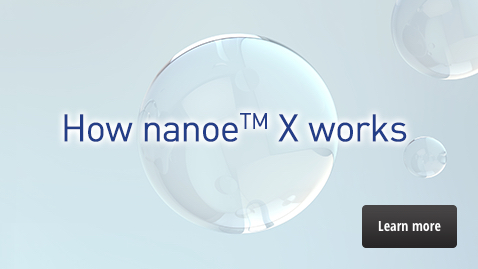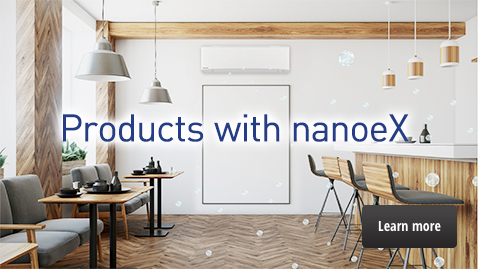What's nanoe™ X?
Question,
What’s the difference between hypochlorous acid and nanoe™ X?
Answer,
Hypochlorous acid has sterilization and deodorising effects, but requires maintenance such as the supply of water and salt tablets.
nanoe™ X contains many hydroxyl radicals, and is characterised by mild acidity, so it is gentle to the skin and hair, and has a wide range of effects such as inhibiting certain pollutants, moisturizing skin and hair. It requires no maintenance.
Question,
What’s the difference between UV sanitisation and nanoe™ X?
Answer,
UV sanitization works on airborne pollutants. It is not effective over large areas as it works line of sight. And UV rays can be harmful to human health. nanoe™ X can inhibit not only airborne pollutants, but also adhered pollutants, including certain bacteria and viruses, and has a long lifespan of about 10 minutes. It is effective over a room space and can penetrate deep into fabrics because of the small size of its particles.
Question,
What's the difference between filters and nanoe™ X?
Answer,
Filters can trap airborne pollutants. nanoe™ X can't trap airborne pollutants, but reaches pollutants in the air directly, having the capcity to inhibit them. And nanoe™ X can effect adhered pollutants as well.
Question,
Does nanoe™ X smell?
Answer,
nanoe™ X itself has no odour. However, since a small amount of ozone is produced when nanoe™ X is generated, there are traces of ozone smell. The amount of odour is equivalent to the amount that exists naturally in forests and elsewhere, and has no effect on the human body.
Question,
What is the lifespan of nanoe™ X?
Answer,
nanoe™ X lasts about 600 seconds, which is about 6 times longer than ordinary air ions.
Question,
Is nanoe™ X an ion?
Answer,
nanoe™ X is hydroxyl radicals (highly reactive components) contained in water. It has a lifespan 6 times longer than ordinary ions and contains more than 1,000 times as much water. The property is mild acidic that is gentle on skin and hair.
Question,
What is the principle by which nanoe™ X is generated?
Answer,
Moisture from the air is condensed and concentrated at one point on an atomisation discharge electrode through the principle of Peltier effect, and nano-sized particulate ions, nanoe™ X, are generated by applying a high voltage.
Question,
What is unique about nanoe™ X? (generation method, efficacy, etc.)
Answer,
nanoe™ X itself is based on a principle applied in the technology used in electrostatic spraying.
The uniqueness of nanoe™ X is the fact that its hydroxyl radicals contained in water have a long lifespan, and Panasonic leverages that characteristic to improve air quality and provide beauty care.
Question,
What are hydroxyl radicals?
Answer,
Hydroxyl radicals exist in nature, for example in forests.
Radicals are unstable atoms or molecules with unpaired electrons. Since they are highly reactive, they react readily with other atoms or molecules to form stable molecules or ions.
Thanks to this characteristic they can be used to in taking away hydrogen from the lipids that results to inactivity/inhibition.inhibit viruses and bacteria.
Question,
How many hydroxyl radicals are generated per second by nanoe™, nanoe™ X generator
Mark 1 and nanoe™ X generator Mark 2?
Answer,
nanoe™ generates 480 billion hydroxyl radicals per second (0.48 trillion). nanoe™ X generator Mark 1 generates 4.8 trillion hydroxyl radicals per second. nanoe™ X generator Mark 2 generates 9.6 trillion hydroxyl radicals per second.
Question,
How is the quantity of hydroxyl radicals in nanoe™ X measured?
Answer,
The quantity of hydroxyl radicals in nanoe™ X is measured using the ESR (Electron Spin Resonance) method.
Maintenance
Question,
Is regular maintenance or replacement of a nanoe™ X generator required?
Answer,
A nanoe™ X generator requires no maintenance, as its atomisation electrode is enveloped in water during the generation process and it is made of titanium so it does not wear down.
Note: The durability of the nanoe™ X generator installed in a product may vary based on the product it is installed in and that product’s use.
Safety
Question,
Isn’t ozone produced in nanoe™ X generation?
Answer,
In principle, ozone is produced when nanoe™ X is generated, but Panasonic has a method to reduce the amount of ozone produced to a level that does not cause problems, utilizing our advanced generator design and control technology.
Question,
What is the impact of ozone produced in the generation of nanoe™ X on the human
body?
Answer,
The concentration of ozone generated in the process of generating nanoe™ X is not significantly greater than that found in nature, such as in forests, and has no effect on the human body.
Question,
Does nanoe™ X have adverse effects on the human body?
Answer,
The safety of nanoe™ X has been verified by 3rd parties with respect to the following issues:
A. Impact on chromosomes
B. Impact on respiratory organs
C. Toxicological and carcinogenic impact
D. Impact on DNA
E. Impact on male and female fertility and unborn children
Question,
Do hydroxyl radicals act only on the lipids of the skin. Don’t they enter the body?
Answer,
Hydroxyl radicals do not enter the body. They act on the lipids on the surface of the skin. Hydroxyl radicals do not remove hydrogen atoms from the lipids. Hydroxyl radicals react with lipids, and the lipids act as a hydrophilic group that coats the entire skin. Since moisture in the skin is prevented from evaporating, this helps to moisturise the skin. Hydroxyl radicals are safe even when inhaled.
Question,
Does nanoe™ X also inhibit bacteria that are good for people?
Answer,
Since nanoe™ X cannot distinguish among the substances it inhibits, it may also inhibit bacteria that are good for the human body. However, it does not have the effect of inhibiting bacteria inside the human body.
Effectiveness
Question,
Is nanoe™ X effective when the air conditioner is installed in a very large space?
Answer,
It is important to install the appropriate air conditioner for each space in accordance with specifications. nanoe™ X is carried quite far on airflows, and its effect is verified by third parties.
Question,
How many devices are needed to ensure nanoe™ X is effective in a very large space?
Answer,
Effects can be expected when nanoe™ X devices of appropriate specifications are installed.
Question,
What effects does nanoe™ X have?
Answer,
nanoe™ X is effective in inhibiting viruses, mould, pollens, allergens and hazardous substances, as well as in deodorising, and in moisturising skin and hair.
Question,
Can nanoe™ X collect PM 2.5?
Answer,
nanoe™ X cannot collect PM 2.5 particles. However, nanoe™ X can inhibit hazardous substances which are known to be found in PM 2.5.
Question,
Does nanoe™ X damage materials like leathers or other fabrics or electrical equipment?
Answer,
Based on our studies and tests to date, nanoe™ X does not damage materials like leathers or other fabrics or electrical equipment.
Question,
Does nanoe™ X have an influence on wireless LANs or other high-frequency technology?
Answer,
nanoe™ X does not influence wireless LANs or other high-frequency technology.
Question,
Is nanoe™ X effective in ventilated spaces?
Answer,
nanoe™ X is expected to be effective when products of appropriate specification are used in a space, including when ventilation is used.
Question,
Is nanoe™ X effective on odours which have not yet been tested?
Answer,
Panasonic testing indicates that nanoe™ X works on many different kinds of odours. Since hydroxyl radicals, which are contained in nanoe™ X, are highly reactive, nanoe™ X is effective in inhibiting the odours of organic substances.
However, there are many substances such as perfumes, considered to have a pleasant odour, which are highly stable and concentrated, and on which nanoe™ X may have no deodorising effect..
History
Question,
How did nanoe™ development start?
Answer,
Noting the fact that water has the property of dissolving substances that cause odours we began studying the possibility of applying this property to purification of air in the living environment.
Question,
How long has Panasonic been developing nanoe™?
Answer,
Research began in 1997, and in 2001 we began developing the technology to generate nanoe™.
Question,
How has nanoe™ evolved?
Answer,
Ongoing development of the atomisation system has increased the volume of hydroxyl radicals generated, the key element of effectiveness.
Question,
Is there any room for further evolution of nanoe™ X in the future?
Answer,
Yes. We hope to continue to meet the demand for higher air quality.


